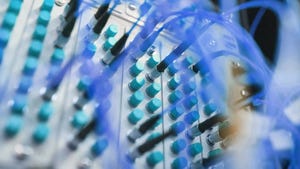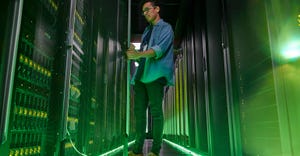
Insight and analysis on the data center space from industry thought leaders.
Enhancing Data Center Safety with Smart Cable Seals
Cable seals are key to protecting data centers from fire and flooding, writes Andy Dyson.
March 6, 2024

The demand for the remote storage, processing, and distribution of large amounts of computer data continues to grow at pace. And as data centers develop in size globally, there is a constant challenge to manage fundamental risks.
Whether an organization is building its own cutting-edge data hall or designing data centers to house customers’ computers, a multitude of challenges must be dealt with.
The use of smart and certified sealing solutions helps to ensure safety and efficiency, both during the construction phase and throughout the lifecycle of the facility.
The bottom line is that interrupted service or lost data is not an option. Meanwhile, there is consistent pressure to handle increased server density, power needs, and heat loads in an eco-friendly and economical way.
Safety First
The demand for safety and fulfilled service agreements calls for more than a fire stop around cables and pipes passing through walls, raised floors, and cabinet structures.
Data center managers require robust and versatile solutions that protect against multiple hazards, including the effects of lightning strikes, gas, fire, dust, flood, humidity, rodents, electromagnetic disturbances, and the risk of explosion.
Take flooding: the extreme weather events that are becoming increasingly common can cause outages with massive cost implications. Selecting purpose-built sealing solutions can save your data center from drowning.
Underground power distribution and fiber networks must be protected against the constant threat of water. Every cable pit/vault or hand box represents a possible leak path and is a risk for the entire infrastructure.
Securing power supply and power distribution is critical for maintaining uptime. Sealing cable buses and conduits, switchgear, generators, and transformers is vital to avoid equipment failure because of water entry.
Power and fiber cable entries into the exterior building envelope need purpose-designed seals. Without properly engineered solutions, these entries also become an ingress point for water, with the risk of damaging equipment or increasing humidity levels.
Certified Protection
In addition to sealing against water, there is also the important need to meet fire requirements whilst maintaining the integrity of the structure.
To that end, it is vital to make sure the solutions used above ground are fire-rated to provide certified protection.
There are also environmental and financial advantages to installing a complete gas-tight sealing system. It will help in controlling the facilities’ climate and temperature, eliminating risks to sensitive equipment.
It is important to understand that within data centers the cooling infrastructure may use more power than the IT equipment itself, and energy costs tend to exceed any other costs.
As a result, data center operators around the world are putting special focus on seals as they work to manage cooling and recycle excess heat.
Scalable Projects
The nature of the data center industry means future-proofing is another important element when it comes to building and design. Expansion is always in mind.
Both modular and containerized data centers are being constructed with eyes on the future when it comes to space, power supply, redundancy, data storage capacity, and sustainability.
That makes it equally important to use cable seals designed for scalable projects. The right seals can make it easy to trace cables, with engineers even able to install them around existing cables.
Having built-in spare capacity for additional cables and pipes means last-minute design changes or increased server density can be easily handled. Retrofit work can be carried out without having to shut down any services or add any material costs.
Data center projects vary greatly, from brick-built constructions to steel and prefabricated facilities. That means that as well as being robust, cable seals also need to be highly adaptable.
They might be needed on power and control system cables passing through underground building foundations, or on fiber-optic and transmission cables ranging from Category 5 to Category 7.
There may also be further use on cooling pipes of different sizes and materials, and on cables and pipes passing through interior and outer walls, substations, control rooms, control cabinets, cable ducts, and fiber ducts.
Air-tight round or rectangular seals can be applied to single or multiple cables or pipes anywhere – in outer walls, between compartmentalized security zones and in control cabinets.
They should be adaptable to power, fibre, coax, and signal cables as well as cooling pipes of different sizes and materials, reducing the need for drilling holes.
Tried and Tested
With the constant challenge to deliver ever-improving safety solutions comes a continued focus on rigorous testing and certification.
The increasing demands on the industry mean we are constantly being challenged.
The Roxtec expert team recently partnered with Euroclad, an international supplier of architectural metal building solutions, to carry out joint fire resistance testing of products.
Roxtec seals were installed into Eurobond external wall panels for a two-hour resistance test carried out by experts from Warringtonfire, global leaders in fire safety services.
In the end, the rigorous test was concluded after almost three hours with fire resistance still maintained.
This successful physical testing gives specifiers and clients new options and comfort in knowing they are using certified products.
Andy Dyson is Market Manager for Data Centers at Roxtec. Roxtec was founded in Sweden in 1990, with its UK base in Bury, Greater Manchester. It is now the global leader in the manufacture of innovative cable and pipe transit systems, supplying many of the world’s biggest firms. It is active in 80 markets.
About the Author
You May Also Like







